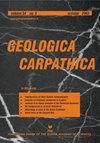克罗地亚Hrvatsko Zagorje盆地早期萨尔马西亚火山活动的证据:矿物学、地球化学和生物地层学方法
IF 1.5
4区 地球科学
Q4 GEOSCIENCES, MULTIDISCIPLINARY
引用次数: 2
摘要
:在hvatsko - Zagorje盆地的sutra - ii柱中发现了一层膨润土粘土层,该盆地是潘诺尼亚盆地体系西南边缘带的一部分。粘土的成因为长英质与中间火山灰的蚀变,沉积于海洋环境下的水平层状泥灰岩之间。物源分析表明,泥灰岩为以长英质烃源岩为主的混合烃源岩。因此泥灰岩中的蒙脱石不仅是陆源的,也可能与火山灰风化有关。根据化石含量推断,膨润土夹层沉积的时代为早萨尔马提亚时期。沉积学和古生物学资料支持沉积在古环境条件不稳定的内陆架地区。sutra - ii柱上部沉积于高能环境中,由不纯的生物钙屑岩和生物钙屑岩与化石岩屑岩相结合,标志着较老岩石和化石地层的强烈再沉积。膨润土可能来源于遥远的火山喷发形成的火山泥,位于喀尔巴阡—潘诺尼亚盆地体系弧后裂谷期的东北部。本文章由计算机程序翻译,如有差异,请以英文原文为准。
Evidence of Early Sarmatian volcanism in the Hrvatsko Zagorje Basin, Croatia: Mineralogical, geochemical and biostratigraphic approaches
: A bentonite clay layer is documented in the Sutla-II column in the Hrvatsko Zagorje Basin, which is a part of the south-western marginal belt of the Pannonian Basin System. The origin of the clay is attributed to the alteration of felsic to intermediate volcanic ash, which had been deposited between horizontally-laminated marls in a marine environment. Provenance analysis indicates that the marls were sourced from mixed, dominantly-felsic source rocks. Smectite present in the marls is therefore not solely of terrigenous origin and may also be related to volcanic ash weathering. Based on the fossil content, an inference has been made suggesting Early Sarmatian age of the sediment hosting the bentonite clay intercalation. The sedimentological and palaeontological data are in favour of the sedimentation at an inner shelf area marked by unstable palaeoenvironmental conditions. The upper part of the Sutla-II column was deposited in the high-energy environment consisting of impure biocalcarenite and biocalcrudite coupled with fossiliferous litharenite, which all mark an intensive redeposition of older rocks and fossiliferous formations. The bentonite clay likely originated from distant tephra sourced from volcanic eruptions, presumably located in the north-eastern part of the Carpathian–Pannonian Region during the post-rift stage of the back-arc Pannonian Basin System development.
求助全文
通过发布文献求助,成功后即可免费获取论文全文。
去求助
来源期刊

Geologica Carpathica
地学-地球科学综合
CiteScore
2.40
自引率
23.10%
发文量
26
审稿时长
>12 weeks
期刊介绍:
GEOLOGICA CARPATHICA covers a wide spectrum of geological disciplines including geodynamics, tectonics and structural geology, volcanology, stratigraphy, geochronology and isotopic geology, karstology, geochemistry, mineralogy, petrology, lithology and sedimentology, paleogeography, paleoecology, paleobiology and paleontology, paleomagnetism, magnetostratigraphy and other branches of applied geophysics, economic and environmental geology, experimental and theoretical geoscientific studies. Geologica Carpathica , with its 60 year old tradition, presents high-quality research papers devoted to all aspects not only of the Alpine-Carpathian-Balkanian geoscience but also with adjacent regions originated from the Mediterranean Tethys and its continental foreland. Geologica Carpathica is an Official Journal of the Carpathian-Balkan Geological Association.
 求助内容:
求助内容: 应助结果提醒方式:
应助结果提醒方式:


